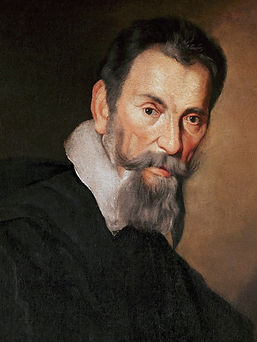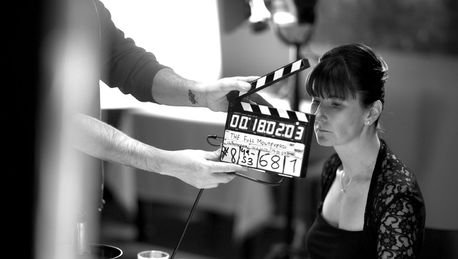
MAKING THE FULL MONTEVERDI

THE MUSIC

Rarely performed in its entirety, Claudio Monteverdi’s Fourth book of Madrigals (1603) is one of the greatest collections of Renaissance music. It explores differing emotional states of abandoned lovers through a sequence of 20 madrigals set to words by such celebrated poets as Guarini, Rinnuncini and Tasso. It was originally intended for private performance before members of the Italian nobility.
This music has since been rejected, celebrated, forgotten and revived but Monteverdi’s purpose can prove elusive for modern audiences tempted to enjoy it as pleasant or even background sound.
"The point of good music is to affect the soul"
CLAUDIO MONTEVERDI
THE FULL MONTEVERDI 'LIVE'
Director John La Bouchardière was convinced that Monteverdi’s work could be more fully experienced if it were given complete attention, if there were a narrative arc to follow and if the conventions of concert performance were stripped bare – if the audience could be engulfed by the music, both figuratively and literally.
Thus was born an early example of immersive theatre, in which La Bouchardière paired a team of actors with the British vocal ensemble I Fagiolini to stage the book of part songs as a continuous narrative about six couples breaking up over dinner, performed in real restaurants, with the action taking place in and amongst audiences of fellow diners.
This ‘surpise music-theatre hit of the decade’ toured for three years, ending after 88 performances with a run at Lincoln Center, New York, and winning the ensemble a Royal Philharmonic Society Award.
“Music-theatre doesn’t come more visceral than this.”
THE INDEPENDENT
“Bleak but brilliant... the surprise music-theatre hit of the decade”
THE TIMES
“The closest one can get to being inside Monteverdi’s head.”
EARLY MUSIC REVIEW
“Nobody could leave the room without believing they had been privy to some sort of miracle of human endeavour. It was witchcraft.”
THE DAILY TELEGRAPH
“A moment in the lives of those present that will not easily be forgotten. I have rarely, if ever, seen an audience as rapt, as engaged with music as on that evening.”
EARLY MUSIC
“An extraordinary experiment in performance style... Never has the 4th Book of Madrigals sounded more personal, more radical, more harrowing.”
THE INDEPENDENT ON SUNDAY
RE-ADAPTATION

The original concept behind the live experience was reinvented for the screen. The film script added narrative depth and detail to provide insights into the characters and their motives and to reinvent the project’s juxtaposition of art and life by placing the action in a grittily realistic context and injecting intimate secrets from the past through flashbacks.
The simultaneous story lines of six couples, then twelve individuals, were woven into a complex web of narrative counterpoint, with the cumulative effect of a polyphonic ensemble, in which one thread takes focus while all are present.
SOUND RECORDING
Apart from background restaurant noise in the opening scene, the sound world is Monteverdi's and his alone. The music was therefore prerecorded and sung to playback on set, with minor lip-synching issues tightened in post-production.
The experience of so many live performances was invaluable in ensuring that dramatic intention would match the acting and cinematography to come. From a practical standpoint, this meant we did not need to record sound on set, and the singers were not required for filming each other's scenes and on location.

FILMING
A chic, urban restaurant setting. complete with its own bar and lavatories, was designed and built in painstaking naturalistic detail, with food served by waiting staff and with extras in support as supplementary diners. The flashbacks and 'morning after' scenes were shot on location, in ordinary streets, trains stations and bedrooms. Costumes were everyday clothes; mascara ran.
Performances were vulnerable and unflinchingly raw, drawing on the depth of characterization built up over years of touring the live show, while the camera’s voyeuristic eye exposed each character with an observational cinematic style that progressively invaded their privacy and delved into their pain. Changes in focus used harmonic shifts to accentuate the divide between the lovers so that, as with the rhythm of editing, Monteverdi's score remained the film's primary driving force.
PRODUCTION GALLERY
DISTRIBUTION
The Full Monteverdi was privately financed and pre-sold to television and DVD. The film premiere was at London's Southbank Centre, followed by screenings across European music festivals, and a global release by Naxos Records.
The film was released on television in multiple versions (single 1×60 film; mini-series 3×25; bite-size shorts 5×15). It has been broadcast by NRK (Norway), The Arts Channel (New Zealand), CTV (Czech), SVT (Sweden), ATV (Quebec), SBS (Australia), Sky Arts (UK), YLE Teema (Finland), RTVE (Spain), TVP (Poland) and Music & Arts (South America).
Although not part of its distribution plan, the film enjoyed a later theatrical release in cinemas across both South Africa and New Zealand.




























" If you love Monteverdi, get this. If you think you might like his music, get this.
If you've tried to listen to his music, but haven't quite managed to into it, get this. If you've never heard of Monteverdi, get it."
AMERICAN RECORD REVIEW
DIRECTOR'S NOTES
When I originally created The Full Monteverdi, I worked with I Fagiolini’s singers and our choice of experienced actors to devise a whole web of narrative richness for the show. Each couple (made up of a singer and an actor) needed a story that would help create a single line through the 20 numbers that make up Monteverdi’s Fourth book of Madrigals. What we came up with, essentially, was six separate but simultaneous plots (that is, one per couple) of quite different natures but sharing one essential imposed structure.
-
The couples would have agreed, coincidentally, to meet in the same restaurant.
-
By the time the singing started, each actor had stated that they wanted to end the relationship.
-
All but one of the couples would make a last-ditch attempt to solve their relationship sexually. The now infamous “No.16” is one of the most explicitly erotic pieces of music I’ve ever heard – especially when it is shared between believable characters and sung with the desperation suggested in the text.
-
All the relationships would fail, with the actors leaving the singers to contemplate their lonely lives.
-
The reasons for the break-up had to be tough and the stakes had to be high, in order to justify the extremes of emotion in the music. The difference between these reasons, however, created a fantastic tension between the couples – each with its own specific relationship to the music and the text – and very different journeys through the charted route.
Of course, that was the live show, when the audience had at least some sort of view of the whole ensemble, throughout, and was caught up within the vocal polyphony. But how does one re-invent that for the screen? Well it’s an ensemble film and there are plenty of models for that. I can’t think of any that are sung throughout, as a continual reminder of the stories you’re not watching, though.
My initial instinct was, during one of our exhausting tours (and therefore wrong, I hope), that the only way to replicate the show on film would be to employ a 24-style split-screen technique, enabling viewers to keep track of more than one story at once. However, though that might have been very beautiful (it would have been great fun creating a visual counterpoint to the polyphony with the screens), it would have been a very self-conscious conceit. On reflection, I realised that one of the many great strengths of the project was the juxtaposition of high art and real life: any unavoidable conceit would have denied its shattering realism. In any case, the film will not be a replication of the show on screen. It has to work in its own right in a medium poles-apart from the original, using the long life of the show as fantastically well-researched resource.
One massive advantage of film is its ability to tell stories and this lead me to explore the backgrounds of the characters and couples in a way we could never hope to communicate in performance. Why are they breaking up? Has there been an infidelity? Where are they from? What are the repercussions of the stories for the poor individuals involved? The result, on paper at this stage (though more fully realised in my head), follows the same essential structure above but intersperses it with flashbacks – allowing clear and acutely upsetting insight into the lives of the characters on screen. The journeys no longer have to remain within the restaurant either, though I have allowed myself one further conceit – bar the coincidence of the couples being in the same restaurant at the beginning.
John La Bouchardière, December 2006











